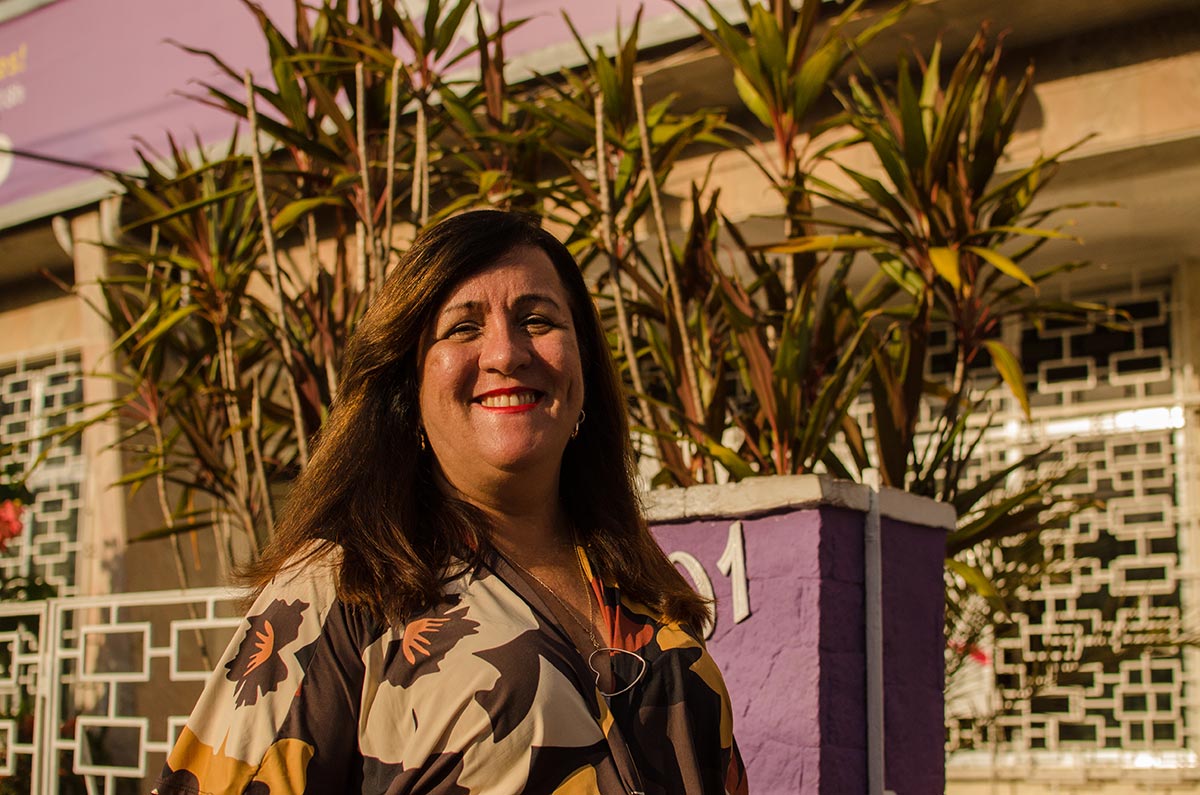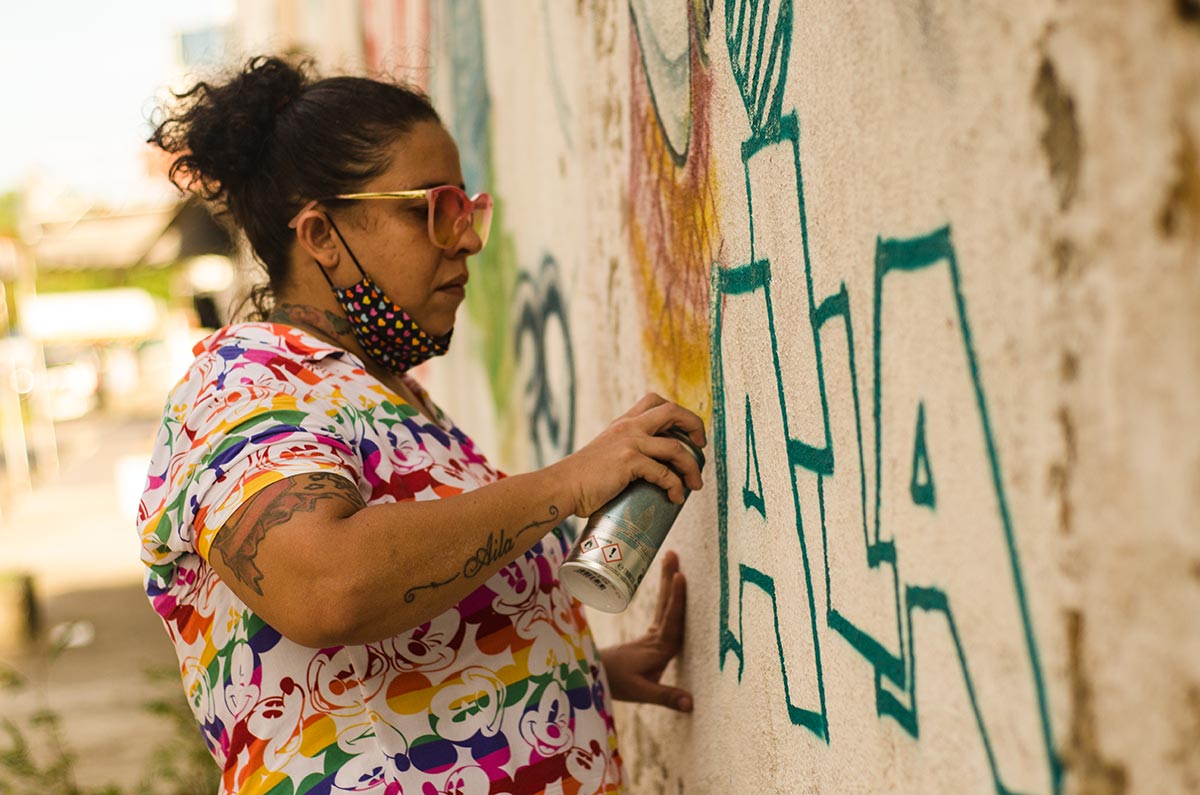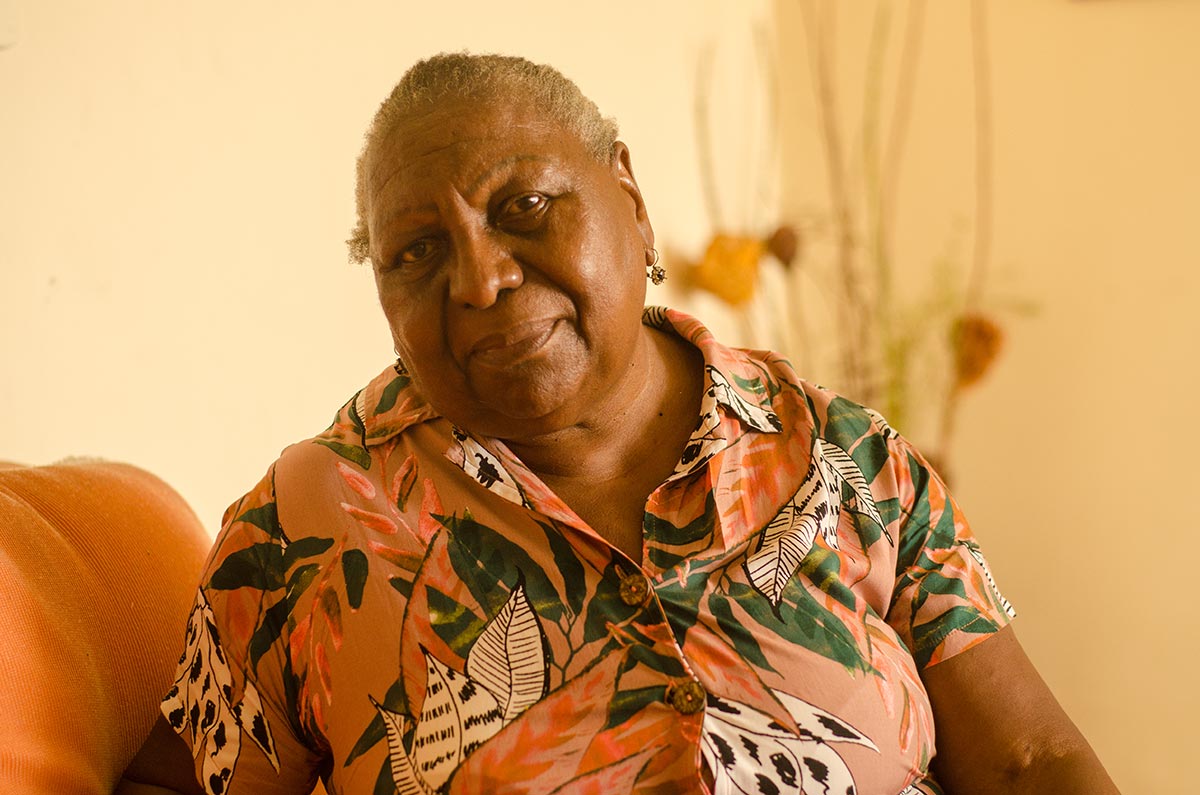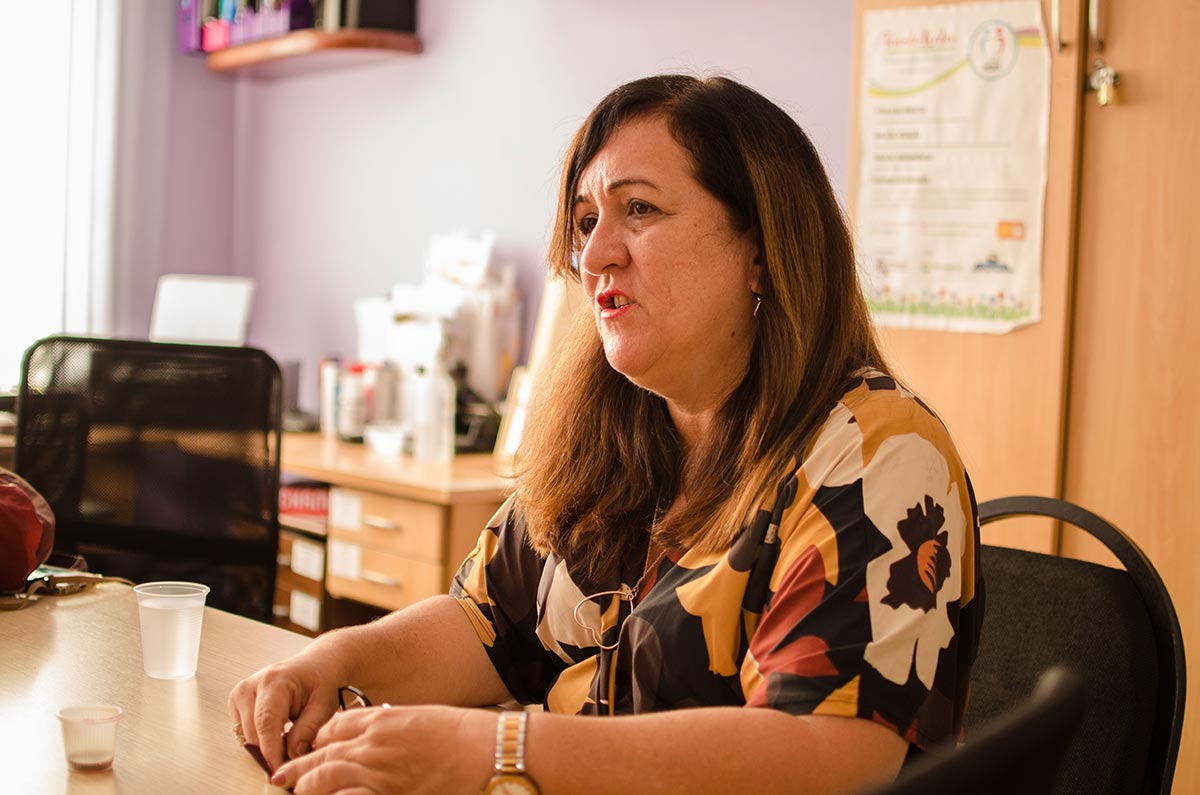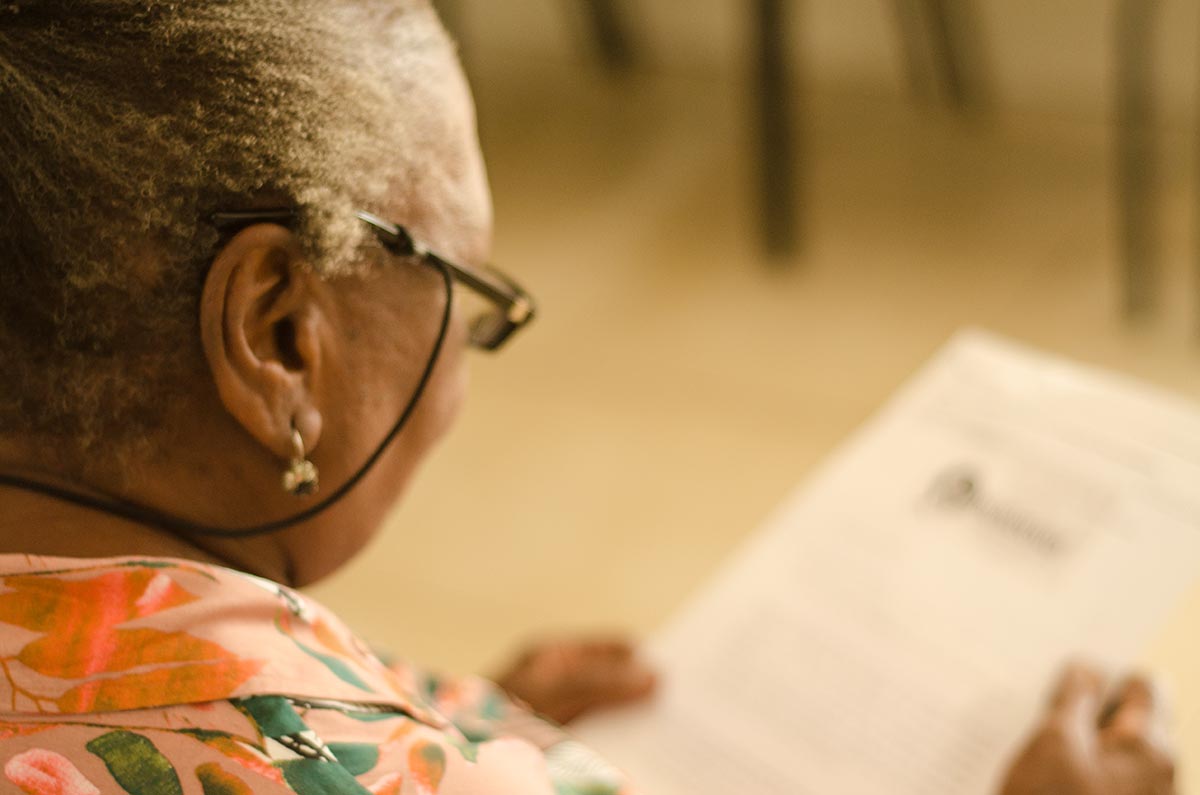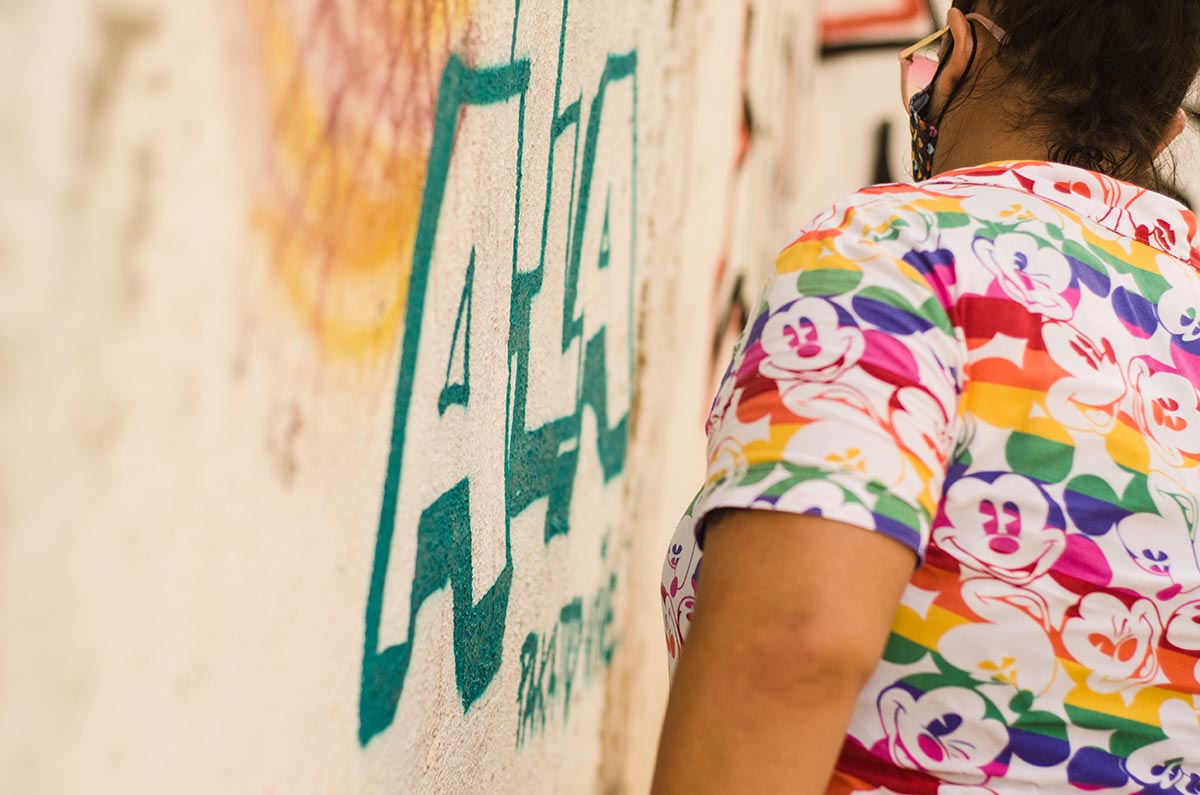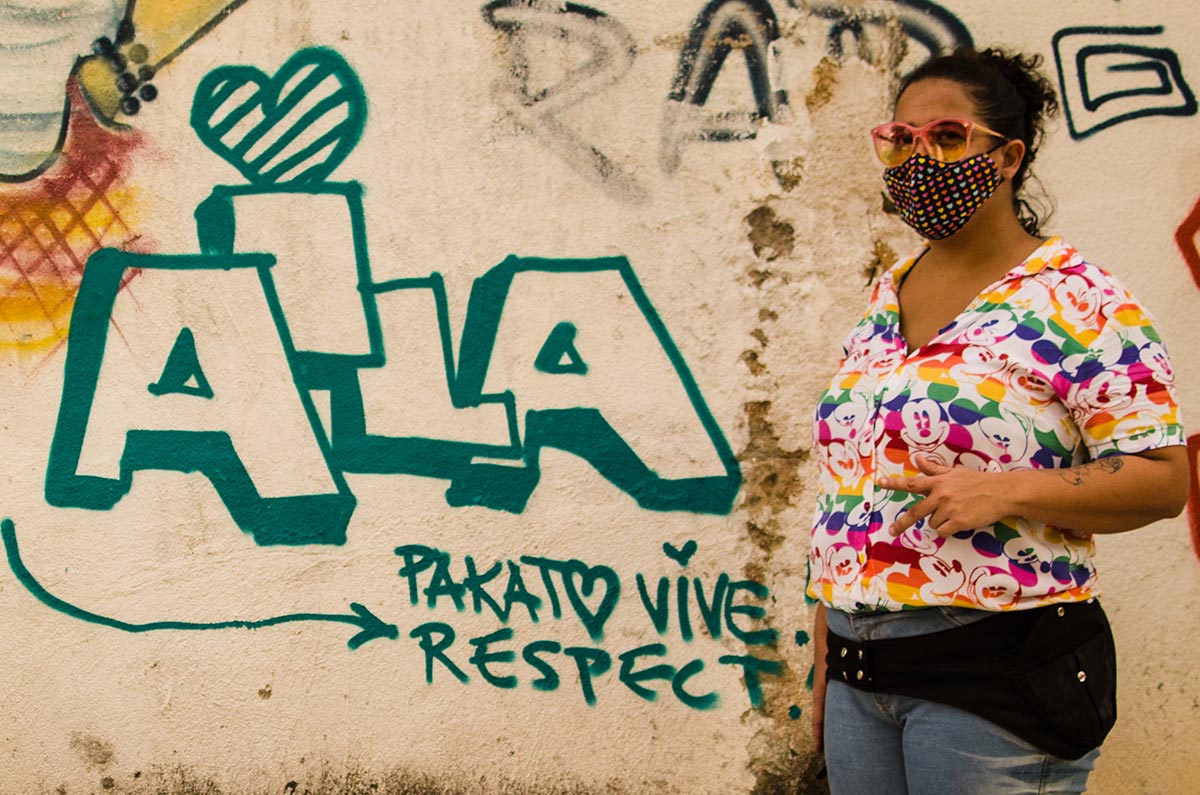São Gonçalo Ahead: Shedding Light on the Hidden. Reports of Women’s Resistance: Marisa Chaves, Oscarina Siqueira, Cristhiane Malungo, Aila Ailita
Renata Bazilio (text) Laura Lima (images)
While traveling around the city, completing my internship as a teacher in geography in a community pre-university entrance exam, I came across a slogan from the NGO Movimento de Mulheres (Women’s Movements) in São Gonçalo (MMSG). I twisted my neck around on the bus to catch the message. At the time, I was immersed in the studies on hunger of [the Brazilian physician and activist] Josué de Castro. Accessing the institution’s website, the Alternativas Alimentares (Alternative Alimentation) project grabbed my attention. While substantively focused on the objective of giving cooking classes to teach about an integrated approach to alimentary health and aimed at reducing the high rates of malnutrition present in the municipality, the project was also a means of disseminating information about women’s health and rights. It was as much a political act, initiating the construction of a support network to “un-hide” violence and empower victims, as a gesture of care and protection for women, enabling a transversal approach of political care via emphasizing the importance of nutrition.
All this made me want to learn more about the organization and to understand how the relationship between territory, gender, and resistance materializes itself in practice. In 2011 and 2012, I worked at the MMSG in two initiatives: as a research intern at the NACA Project (Assistance Center for Children and Adolescents) and at NEACA Project (Special Assistance Center for Children and Adolescents Victims of Domestic Violence and Sexual) where I developed and mapped social networks and mobilizations. In monitoring these networks and the mobilizations I could see how the domestic context has its risks and possibilities, representing micro and macro-territories of the movements’ struggles. The home is an environment in which women, children, and adolescents are subjected to danger.1 What genuinely represents shelter is for many filled with the daily experience of the imminent fear of violence, often without community support, backed up by the popular saying: “no one gets involved in a fight between husband and wife”, or children for that matter.
From the abyss of homes historically marked by culturally inscribed sexism, women have taken their concerns to the streets to promote awareness of gender inequalities and to guarantee citizenship based on human rights. This discontent has been a key driver of solidarity for women’s and feminist movements around the world and has been an active force in the networks taking shape in São Gonçalo since the end of the 1980s, shedding light on these invisible warriors and wars. As an example of actions that deserve and need recognition, the strength of resilience of being Goncalense is shaped by a peripheral reality that is evidenced on the ground due to the absence and neglect of public power. Collectively these movements combat terror with open arms and disinformation with public presence and form a network of prevention and protection comprising people and institutions supporting victims of domestic and family violence.
With a view to honoring these struggles, this essay updates research carried out for a bachelor’s degree in 20132 together with reports recently collected in interviews via WhatsApp (given the context of the pandemic) with: Marisa Chaves, founder and project manager at MMSG with a masters in social work from Universidade Federal Rio de Janeiro (UFRJ); Oscarina Siqueira, pedagogue and executive director of MMSG; Cristhiane Malungo, pedagogue with the Municipal Secretariat of Social Assistance and Human Rights of Niterói coordinator of the State Forum of Black Women of Rio de Janeiro and former MMSG collaborator; and graffiti artist Aila Ailita, active in the Municipal Education Foundation of Niterói and witness to abuse and domestic violence in her childhood. The interviews are accompanied by a photo essay by Laura Lima de Souza Santos, a teacher and photographer from São Gonçalo who has also researched these significant movements for her master’s degree in sociology.
By demonstrating the effective participation and contribution of women working for change in political, social, cultural, and artistic spheres, this essay aims to illuminate the hidden lives and struggles of those effected by violence against women, children, and adolescents.
Hidden Lives and Struggles: Confronting Violence Against Women
The conquest of the Maria da Penha Law, the result of efforts to bring visibility to women’s demands, strengthened the struggle by defining violence as not only physical, but also psychological, sexual, moral, and patrimonial. The law’s impact can be seen in the increase in the recognition of cases of abuse and in the number of aggressor denunciations, placing São Gonçalo as first in the national ranking of Brazilian municipalities with recorded claims of violence against women. This can be understood as Marisa Chaves notes, from the perspective that “information is power”, because the courage to break “the vicious and silent cycle of violence” is based on self empowerment, on the will to live one’s life, meaning that requesting help and reporting are important steps. São Gonçalo has more than 40 specialized and non-specialized institutions across public security, health, social assistance, judiciary and public policies distributed in the city’s five districts that are aimed at serving women.3 In our interview, Marisa describes the situation:
In territories where there are more open institutions, campaigns being carried out, printed material and digital material being disseminated, women have become more aware that they are not alone and that is why there is an increased rate of claims. São Gonçalo has always been ahead because it has more open doors. The municipality that has no record and that appears at the end of the curve, as if there were no violence, is perhaps, hiding out, pointing to a serious problem. So, with more open institutions, with more actions, I think the more you remove [these issues] from invisibility (…). But there is a curious fact. São Gonçalo has seen a drop in the homicide rate against women, which since 2015 has been classified as feminicide.4 This drop in feminicide may be due to the prevention work and the open door [policies] that allow women to seek help before the situation becomes [irretrievably] aggravated.
The solidarity of social action and the political strength of women’s actions and organizations acquired over time, “place this municipality among the first to move forward in debates and invest in public policies for women.”5 These collective articulations counter the political game with resistance, demanding a change of mentality that creates inequalities and subjects women to various forms of violence, where most of the time, no one knows or wants to intervene to draw attention to the dramatic facts of everyday family life. The barriers to a social approach to domestic violence in this context are complex. They range from the ongoing neglect and silencing of women’s suffering to the hidden nature of the protection network that itself emerged due to the scarcity of public investment, the very lack of which being the fuel that drives this fight for citizenship.
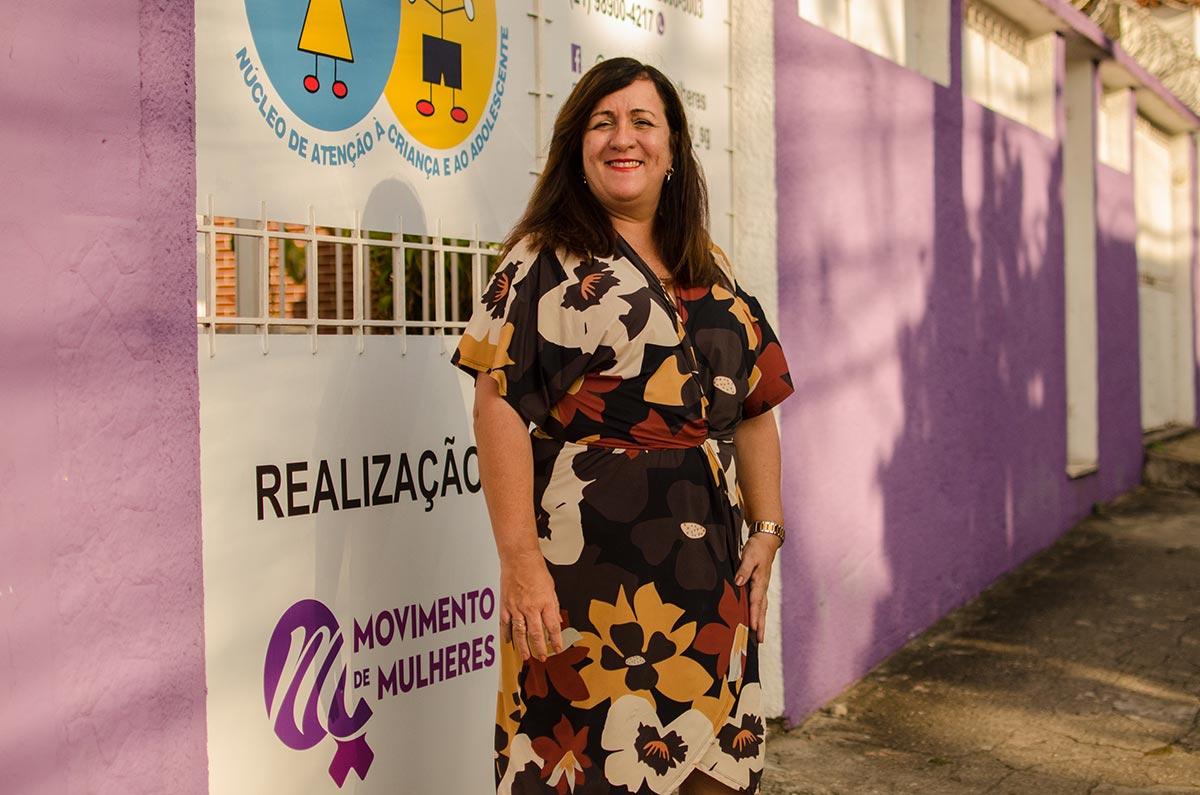
It is precisely in this context that an active civil society of women and feminists has been strengthened and positioned, even though there is no interest in the decline of male power. Making visible this demarcated resistance to power in its collective demand for public policies and publicity campaigns, has been key to a raising awareness. Facing violence by walking the peaceful path, Oscarina Siqueira, comments that “the phrases that women use today: ‘my body, my rules’, I think are here to stay (…). Such positive affirmation is well analyzed, people are strong when they hear certain phrases, it gives them strength.” Even considering more recent stimuli in the defense of rights, there is still a lot of work to be done in deconstructing taboos and ensuring access to information, especially in the peripheral areas of the peripheries, the challenges are profound:
To this day we still find several places where people don’t know about these services. They only know about the police station, but they don’t know about the Specialized Women’s Orientation Center, they don’t know about the Women’s Movement in São Gonçalo. Because of the pandemic, we have had to stop our public lectures. We have been trying to go to more outlying places because we know that here people might not know about [our support mechanisms], often because of the expense of transport. Still today not even 50% of women are aware of their rights. Not long ago, a mother called me. “Do something for me”. I had already given her the Movement’s phone number, the address of the Movement, of the CEOM, the police station (…). But she, the girl did not want to report the abuse, she did not want to. The family was telling her that she had to leave and she thought that if she were to report it, he would make the relationship worse. I said: “But she cannot stay, moving out she will have a protective restriction order, what she has to do is stay away from him.” But we know we can’t impose, we can only show what we already know about these scenarios. Yet often the person says “It will get better, I will not put up with this anymore…” and she goes back and gets hit again.
The community recognizes the social importance of Oscarina and all those involved in this cause including the institutions. That their work is carried out far from the spotlight amidst the struggles of everyday life is their great accomplishment. Presence is key to ensuring that the paths they have constructed lead to action. Keeping women’s agendas in the dark is still a habit of male domination that is gradually breaking down. Even if the work of these organizations is interpreted as inglorious activism in the eyes of power, they have shown that they can save lives and have welcomed many affected women and family members.6 From the perspective of the network, once a tragedy of violence occurs, the objectives of mobilization of public policies are realized when the victim becomes part of the Network of Assistance to Women in Situations of Violence. Here the victim can receive advice and assistance from multidisciplinary professionals. It is the conception of solidarity on which this work is based that sustains the network and makes it great, but in view of persistent absences – state and political financial power and support – much of the individual, collective, and institutional efforts continue to remain hidden to the rest of society.
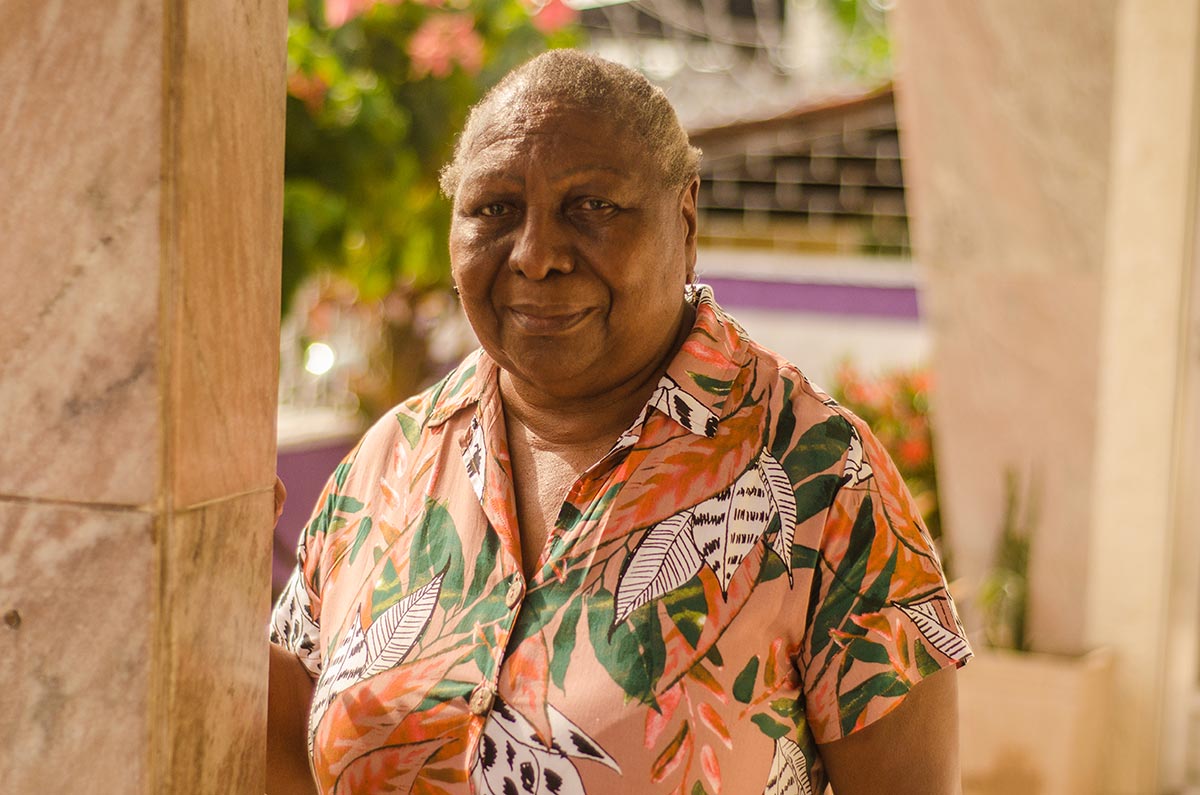
While São Gonçalo camouflage domestic violence, there are many who resist this scenario of invisibility – representatives who engage in political disputes, fight for the struggle for citizenship, social rights, and are part of the welcoming network for victims. However, this does not discourage the quest to improve the lives of those suffering from domestic abuse, on the contrary, it motivates them to expand their actions. Practically and conceptually, history has shown that women’s movements in their diversity have demanded community improvements related to “daycare centers, school vacancies and improvements, health clinics and equipment, etc., […] demands that affect the entire population and all sexes, but have been led by women” and that feminist movements [effectively] interfere in public and social and governmental policy. “They have visibility and give women a voice, they multiply the spaces in which women work, feminists are in NGOs, they lead marches, protests, etc.”7 These social movements have also given voice to the needs of children and adolescents, a violent home victimizes women and the impact extends to children directly affected by the situation.
In this way these institutions offer shelter and possibility for women, children, and adolescents by territorially demarcating their approach to dealing with domestic violence and abuse, emphasizing the reception of victims, a core value of the National Policy to Combat Violence against Women (2011) that aims to support all Brazilian municipalities in their care and clinical service networks. The extensive and committed work carried out to improve the network and the member institutions also promotes an ongoing search for visibility of the daily activisms by women and feminists, their presence in public spaces, their claims for citizenship, and also in artistic expressions on the streets that alert to the subjectivities and life experiences.
To highlight some of this history of the struggle for public policies in São Gonçalo what follows illustrates an example of the positive potential of this municipality, one that has been unfortunately tainted by the negative image of the city that circulates in the mainstream media.
The Journey of Struggle and Achievement for Women’s Citizenship in São Gonçalo
The multiple meanings both material and subjective interwoven with the protagonism of the struggle of women and feminists worldwide reverberate as “waves of social transformation [that] affect virtually the entire surface of the earth.”8 Initiatives began in São Gonçalo in the 1980s and a line can be traced mapping the geography and history of political actions and events indicating both advances and setbacks in the fight against violence against women. The details of this analysis are outlined in my undergraduate research project on this history.9 Here, this essay is an opportunity to invite key protagonists to talk about this trajectory and the achievements of women-centered public policies. Reflecting on the history Marisa Chaves recalls:
When I arrived at the police station as a social worker, I went looking for anything that had to do with forms of social mobilization in the city in defense of women’s rights. At the time, I met up with the Women’s Committee, a group of women who were discussing the implementation of the Specialized Police Station for Women (Delegacia Especializada de Atendimento à Mulher (DEAM)) in São Gonçalo. I collaborated with them and we fought for the creation of the Women’s Service Center (Núcleo de Atendimento à Mulher (NUAM)).
And Oscarina Siqueira continues:
I was President of the Colubandê Farmers Association. So I received a visit from a couple, Sueli Berna and her husband: ‘oh, they told me that you are the person here in the neighborhood who runs the residents’ association and we are looking to fight for a women’s police station in São Gonçalo. Would you like to go to a meeting.’ I said ‘okay.’ The Civil Police commander was very strict, and there was a certain moment, he said ‘there won’t be a police station, no there won’t be police station there any more.’ He decided not to create a police station, but rather a Women’s Service Center (NUAM). So, I was part of this committee […] that was in 1987.

Each encounter fostered phenomenological connectivities energizing the periodic meetings of the Committee which increasingly attracted leaders to strengthen the public security agenda and at the same time discuss the execution of the Comprehensive Assistance Program for Women’s Health (PAISM) and the formation of the network of care services for victims of domestic and sexual violence. Following the landmark of the 1988 Brazilian Constitution, the Municipal Council of Women (COMUM-SG) was founded the following year. Due to the lack of services and the need to create an institution that could provide women with necessary and deserved care, these initiatives were integrated into the foundation of the Women’s Movement in São Gonçalo, on March 16, 1989 to be comprised, as stated in the meeting’s minutes, by twenty-five leaders from different neighborhoods and organizations. As a result of the institutionalization of the Movement and their parallel agendas and interest, COMUM terminated. Using the word “movement” as fundamental to the name of the NGO was inspired by both the conceptual reach and real work of women’s and feminist movements.
As an institutional strategy, which also acted as a motivator for the construction of a network to address the theme of violence against women, the first project developed by the MMSG was Alternativas Alimentares. The project developed decentralized actions in more than 45 neighborhoods in the city. Cooking classes demonstrated how to use everything from peel to seed, interspersed with the dissemination of health advice, information about contraception and family planning, and women’s rights in relation to domestic violence. By signifying presence in community life, the strength that the institution acquired over time has been in turn reflected in the political strengthening of the city’s feminist agendas. As a result of this work after a decade of negotiations with the state government, the fight to establish DEAM – the special police station for women – was finally won in 1997, and in the same year, the Special Center for the Orientation of Women (CEOM), Zuzu Angel in the Neves neighborhood, a municipal project proposed and coordinated project by Marisa, was implemented where victim and family members may receive continuous legal, psychological and social service assistance.
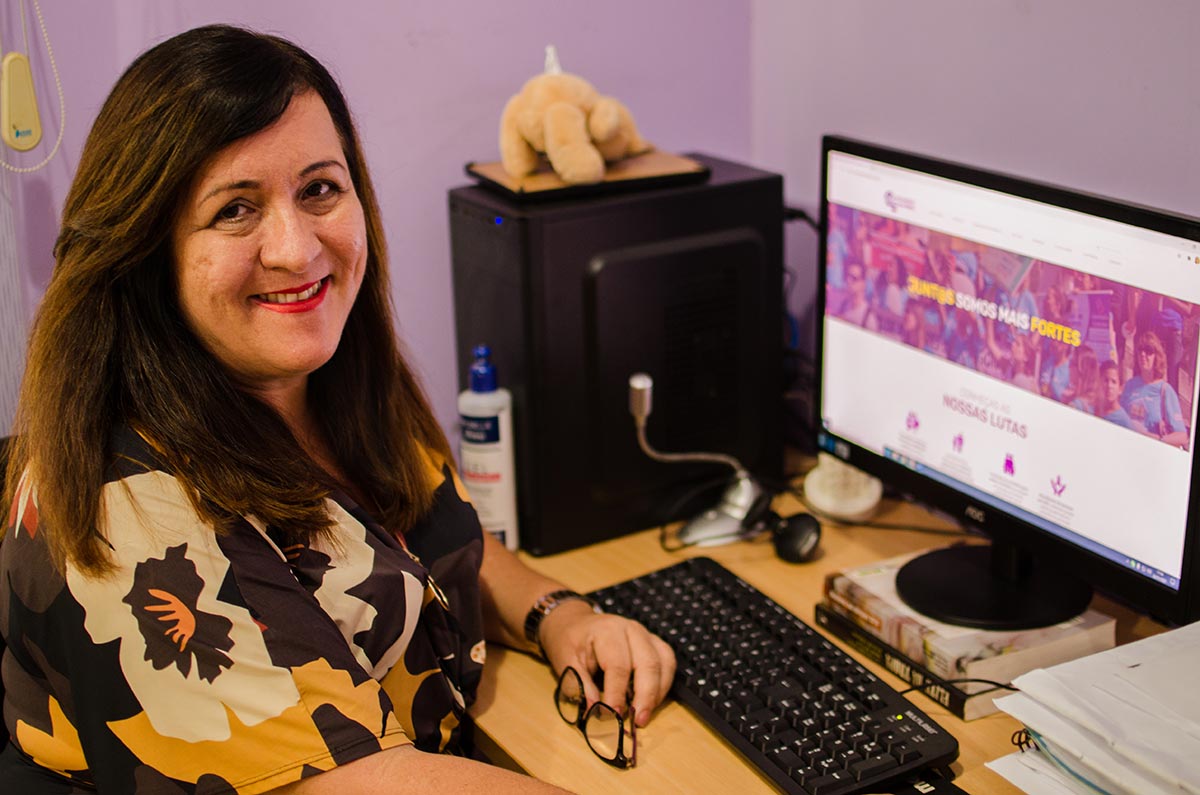
As a result of these mobilizations, the 1st Municipal Conference on the Rights of Women in São Gonçalo was held in 1997. This collective resistance gathered momentum and the 1990s were to finally see progress meeting old demands. Following the election of the first mayor in the city,10 the Secretariat and Sub-Secretariat for Integration and Women’s Policies were instituted. Following the VI Municipal Conference on Women’s Policies (2011), the First Municipal Policy Plan for Women 2011-2013 was creating, directing priorities and actions for the next biennium. These achievements have meant a great collective advance of the cause, in line with the dictates of national policy. In 2011 another treatment center, CEOM Patrícia Accioli, was created in Jardim Catarina named after a slain activist judge assassinated in 2011.11 The center was transformed in 2019 into the Reference and Social Assistance Center for the elderly, women and people with disabilities, embracing other modes of attending to service needs and sharing the budget with two more agendas, with different needs. This points to a political shift in the last decade resulting in the loss of women’s autonomy and the weakening of the territorial strategy aimed at implementing a CEOM in each of the five districts of São Gonçalo.
As one of the fundamental women-centered public policies, in addition to the Center for Assistance to Women, the Specialized Police Station for Assistance to Women and the Specialized Centers for the Orientation of Women, the project Casa Abrigo (Home Shelter) responds to demands stemming from the beginnings of the women’s movement network in the city. Offering “protected housing and comprehensive care for women at risk of imminent danger to their lives due to domestic violence […] it is a service of a confidential and temporary nature.”12 In contrast to the municipal focus of the other centers and organizations the project is regional, that is, it does not receive only Goncalenses. As an achievement, the building was made possible by the partnership between the federal and state governments, and with the completion of the work, the keys were officially handed over in 2012. However, the Municipal Prosecutor’s Office of the Municipality of São Gonçalo demanded the creation of a law to validate the exercise of activities and purchase of permanent equipment, which, unfortunately, has not yet occurred in the two subsequent administrations. The building, still not inaugurated, is now lying vacant [slowly turning to ruin] following eight years of construction to complete, indicating a fateful political divergence with the interests of women, activist movements, and organizations in São Gonçalo, illustrating a typical Brazilian situation of political opportunism and in-fighting where in the end it is always society that loses out.
From the perspective of public visibility, the São Gonçalo Walk to end violence against women stands out stands out, which has been an annual event in the city center on March 8, for International Women’s Day, with the last event been held in 2019. The walk has had to sustain various intervals of less than supportive mayoral influence. The walk publicizes posters and chants common to feminist movements worldwide. The vitality and courage in these actions demonstrate women’s strength when engaged in the power of their own organization.
Over the course of the past two decades the protagonism of the Women’s Movement in São Gonçalo can be seen in public policy debates, the promotion of actions that engage the social participation of a diverse activist base, and in public grant awards. These ongoing initiatives work to preserve the movement’s autonomy, positioning themselves at arm’s length from party politics, while seeking to dialogue with the various levels of government through political conferences and presence in forums and rights councils. In addition, the NGO also positions itself as a service of public utility that by incorporating the needs to address violence in childhood and adolescence has expanded their work. As Marisa Chaves comments there are continued: “gaps […] although we have managed to advance with women’s concerns, such as the achievements of [the establishing of the organizations and centers] DEAM and CEOMs, there has been lack of continuous assistance to children and adolescents, who are also exposed to various forms of rape and abuse.” Responding to this sad reality, the Special Nucleus for Assistance to Children and Adolescents and the Nucleus for Assistance to Children and Adolescents were created, developed as projects of the Women’s Movement NGO.
The movement and their embrace of the political trajectory of women and feminists have raised the visibility of the theme of violence and worked to ensure the protection and shelter network. It is an example of positive potential and resilience in São Gonçalo. As a reaction to the darkness produced by sexism, these activisms and organizations carry with them the sense of hope that reverberates in the lives of women, children, and adolescents who are victims of barbaric crimes in the home, the alarming statistics of which reveal disturbing moral and ethical realities.
The Pandemic, Violence Against Women and the Black Population
With the scarcity of services to meet the demands of women, children, and adolescents who are victims of violence, the MMSG (Womens Movement in São Gonçalo NGO) has in recent years started to take over these services, a fact that has become more evident in the Sars-Cov-2 pandemic. Even with the imposition of social distance, the NGO has kept its doors open and dealt with many cases of rape. Also new forms of communication have been created to facilitate access and the call center available on the organization’s website, has been a crucial tool in this context because “many women access the site using chat options, attended to by various social service specialists, wanted to know their domestic rights, get knowledge and information, and share their doubts” as Oscarina comments. In fulfilling the social responsibility that the State takes little account of, Marisa Chaves speaks of the increase in the number of cases of violence during the pandemic:
What the pandemic caused in the lives of women was increased living time with their aggressor. They had to spend more time with the aggressor and, at the same time, their primary support network had been limited. The primary network is the extended family and the community. As they no longer had this extensive network, nor access to community support, they [also] did not go to work and their children didn’t go to school, they were overwhelmed with many household chores and at the same time, very oppressed because they had no one to turn to [help] in the day-to-day living with this aggressor, so they began to suffer various forms of abuse. I do not claim that violence increased in the pandemic, what increased was the time living with the aggressor. [We know from] the knowledge gathered by the call center that many women thought that the police stations were not registering, that the violence court was not applying an emergency protective custody and they were left with the feeling that nothing was working.
The view from the front line of assistance to victims corroborates with the information that “feminicides and violence against women have increased during the pandemic, but denunciations decreased.”13. The functioning of the services that make up the Municipal Assistance Networks for Women in Situations of Violence has been put to the test, as well as the legal applicability of laws to protect women. Yet, even in such a sensitive context, at the end of the first fifth of the 21st century, structurally silenced agendas have been asserting themselves drawing on the history of the struggle and outlining significant concerns such as those of black women. From the perspective of dealing with domestic violence, it has been an achievement to highlight the statistics according to race and expose the dangers inherent to black women. This is part of a long process of overcoming social inequalities and expanding rights and representativeness. However, within the feminist movement with a strong white presence, there has been resistance to the racialization of violence, weakening the potential for a more plural understanding of the realities and specificities of women’s lives.
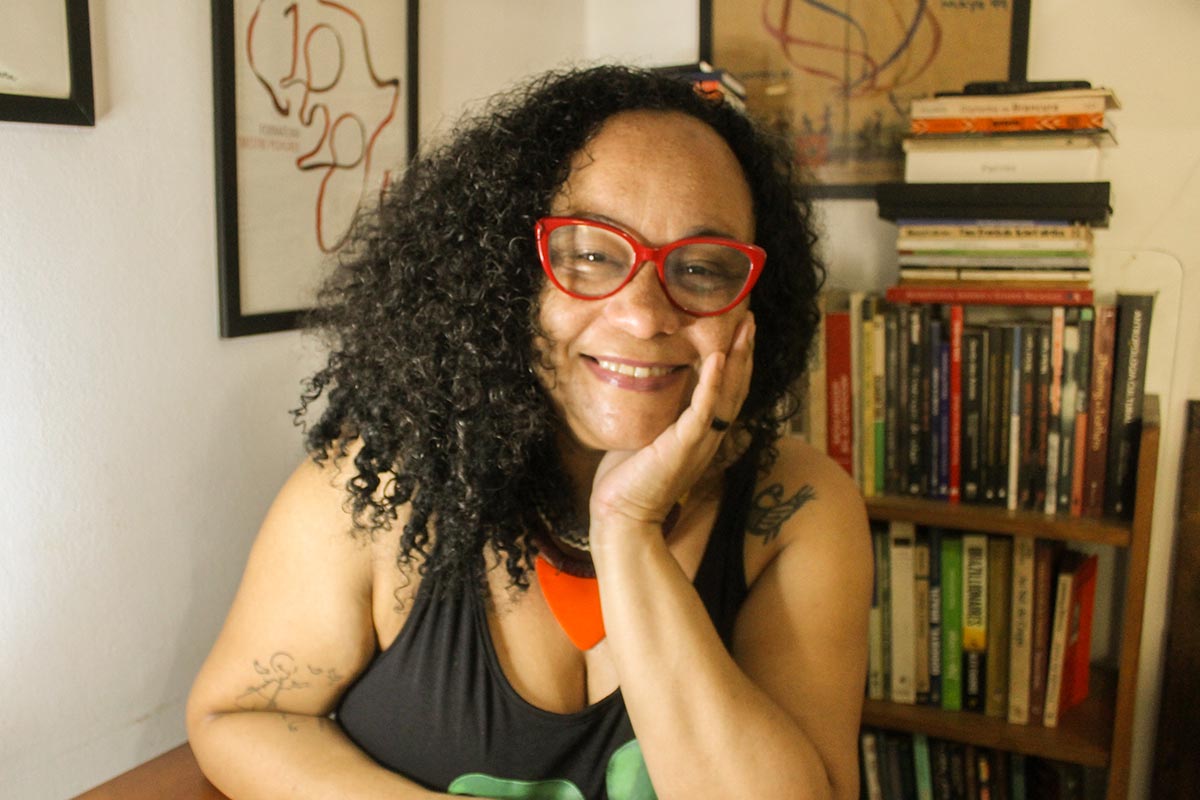
Cristhiane Malungo comments:
If we take the history of feminist struggles, not only here in Brazil, but in general, we have worked on gender for a long time, without a racial perspective. It is as if we could work on gender relations without including raciality as a point [one that I would say] is a significant point and that makes all the difference […]. As black women we have been in this fierce struggle for some time, discussing this issue in the feminist movement and gender within the black movement. We have the capacity here in Brazil, to work on issues related to gender violence and domestic violence, with all the data we have […] black women are the ones most affected by this violence and at the same time, [somehow] we [end up] working on it without racializing. How is it that in a country that historically treats these people as things, that treats black women as a body that was meant to give pleasure or to serve, that treats these women as subordinates, how am I going to think that, almost as if by magic, it won’t exist anymore? We have a culture of violence when it comes to black women and their bodies.
The advance in the visibility of neglected historical structural issues allows the society to be re-signified, towards the promotion of collective social well-being. Whether due to domestic and sexual violence caused at home, or urban violence practiced by the exercise of necropower on the street, or due to the lethality of the coronavirus, the particularities of the black population are urgent. Christiane continues:
When we talk about urban violence, we now have a slightly more refined discourse of genocide of the black population, of the genocide of black youth, of necropolitics, not only killing, physical extermination, but letting people die and how to let them die. We have seen in the pandemic how explicit this has become. There is a virus that will affect everyone, it will not choose. But we have structural conditions that make this virus lethal for one group and not lethal for another. And for which group is the virus the most lethal? It is the poorest group, not coincidentally, the black population.
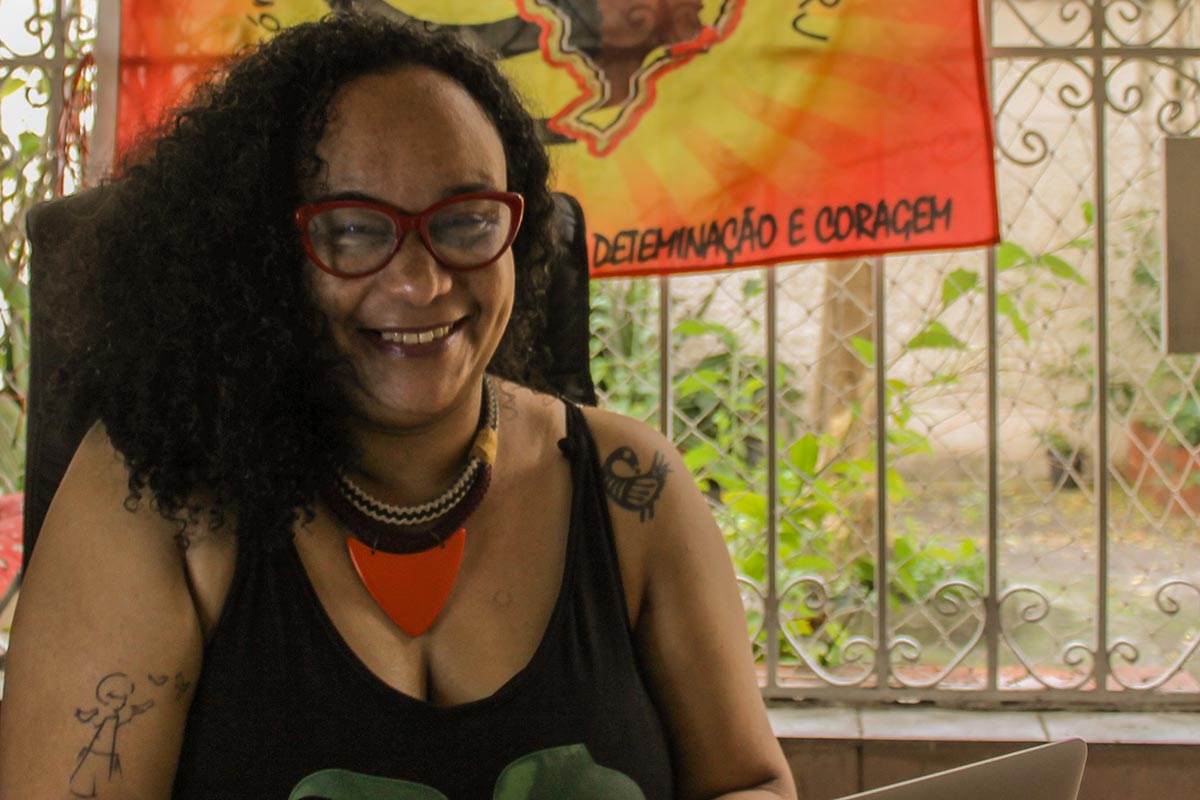
Although advances have been made in education policies through the affirmative action provided for in Law No. 10,639 / 2003, establishing the obligation to teach Afro-Brazilian history and culture in all regular education in the public and private schools, and Law No. 12,711 / 2012, ensuring a quote of vacancies in universities for the admission of black women, the health sector needs similar investments. Structural racism manifests itself significantly in this field, stifling research development and hiding necessary resolutions. Given the black population’s marginalization in different sectors of society, countless efforts have been made to raise awareness and transform these realities.
It is in bringing light to these hidden issues and struggles that the perspectives of hope in social action materialize. Reactions to the oppressions and inequalities that weave historical struggles take place in the daily lives of organizations and the representation of people, ensuring humanized values of interpreting and relating to life and society. Through the chaos created by the power of inhumanity, it is in affirming what has been done to overcome past setbacks that we can see how much progress has been made in terms of solidarity. Presenting examples of potential and resilience for the next generations is key, ensuring that the 21st century is full of reports and initiatives of this nature capable of awakening in the other the awareness of the prisons that can be produced in the home and on the street.
With the experiences related here, what stands out are the processes of permanent struggle, as evidenced in São Gonçalo by the implementation of the Service Network for Women in Situations of Violence, an example of representation and inspiration for Brazilian municipalities to tell their feminist histories and geographies. As they move forward it will be essential to deepen the specifics of this struggle, paying attention to the social bitterness caused by the maintenance of racism. In the distraction of the comings and goings of daily urban life, city walls can be a font where these life’s demands become visible, a world of graffiti where we can grasp expressions and feelings revealing the plurality and emergence of an awareness of human subjectivity.
A Report of Life and Art
Gonçalense graffiti artist Aila stands for this feminist resistance, representing women via street culture.14 She started painting in the 1990s looking for alternative way out, a means of healing, liberation, action and profession, grounding the power of art in life stories. Nowadays, the artist works as a graffiti artist at the Municipal Education Foundation of Niterói. Here she shares her experience and journey marked by domestic violence in childhood and adolescence, revealing the importance of the arts:
I grew up in a violent home. My mother had no education. She was poor, emotionally and financially dependent. My father beat my mother. He was a military policeman, used a baton on her […]. I’ve never seen anything like it [since], honestly, never, only those who killed the woman, feminicide. We lived with this terror that it could happen at any time. He killed my mother every day. It was different. There are many types of violence, but this was hard [core] […]. We grew up with the fear that something would happen because he had two guns in the house, and he was an official, so it was difficult to report him, really complicated […]. This all affected my self-esteem, because people talked, the neighbors judged, their children who would not play with me […], and really art was something that made me stand out, drawing, dancing, my spontaneity, my ease, my taste. I was very artistic; so it made my star shine. I’m fine. Thank God, I survived.
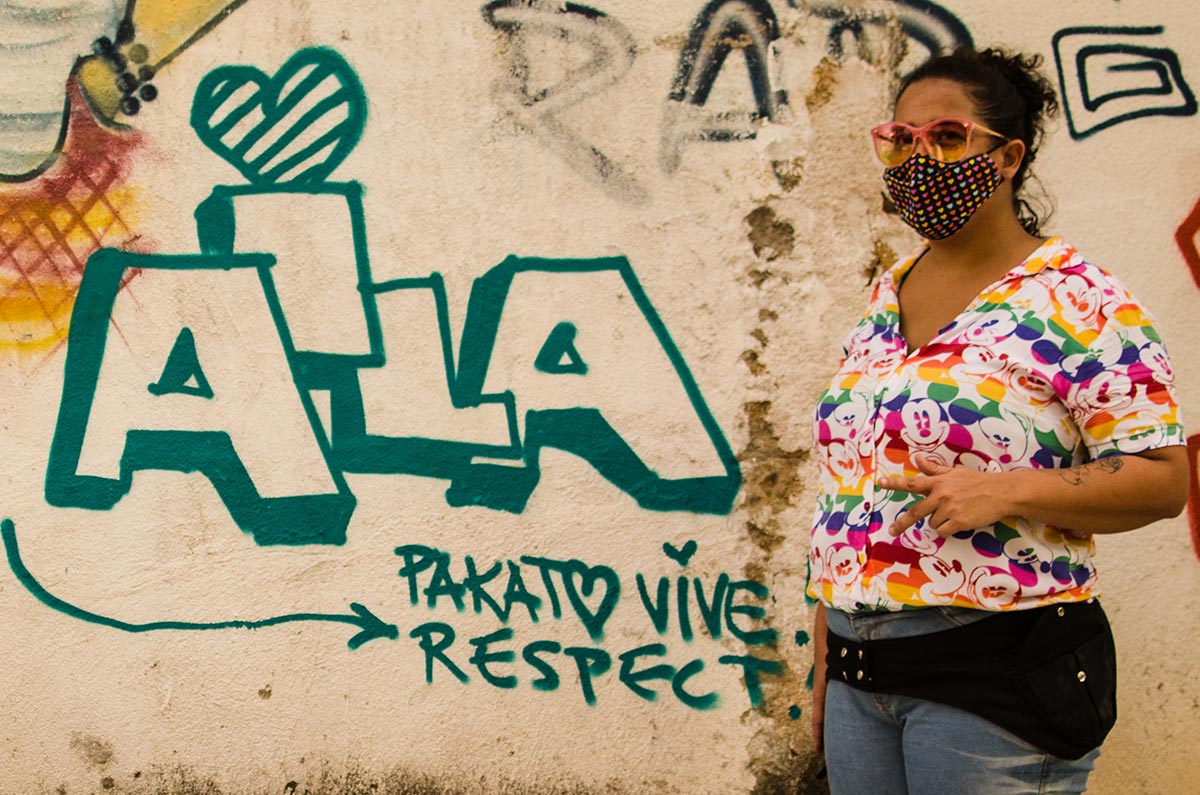
Aila has remained on the street scene since the early beginnings of graffiti art and events in São Gonçalo, considered [by many as] the harbinger of graffiti in the state of Rio de Janeiro. Certainly, dealing with gender issues within this markedly masculine culture could be a separate article, a world in which Aila has survived by positioning herself and overcoming the recurrent sexism in this medium. Her brand is the always smiling doll, communicating the joy in which her graffiti is expressed. As a witness of domestic violence, she has looked for ways to deal with the suffering that has marked her soul.
Art has been part of my life ever since I was a baby, an incentive [spurred on by] my father. I learned to talk to him through drawing. He liked drawings a lot. Then I grew up and [really] liked it and people started to notice, that I was different. It was an incentive, because my grandfather was a draftsman […] but he was not academically trained, […] [he was part of a team that] designed the first torpedo of the Brazilian navy […]. So I come from artists […], I started drawing and continued at school […]. Then I went on to live an artistic life, [difficult but one that is] rewarded in experience, communication, expression, and financial independence. Art in my life is everything, only second to Jesus because he gave me and gives me the strength to continue, positivity […]. So, it was like that, art got to me from different sides […] I carry many wounds from the violence [I witnessed] at home […] the relationship I have with art itself, is something like salvation, like protection, it is my joy […]
Aila’s story sheds light on how art can play a role in facilitating a lucid understanding of the liberation from darkness, the terror of the home, and the emotional and psychological reflexes of living with violence. It is a reference, incentive, and tool for emancipation of the self and the world, and spirituality, in its turn, also guides the path towards the light. Art has ensured that Aila’s dramatic lived reality came out of hiding, and by doing so she offers an example for countless families that go through the daily labyrinth of male oppression. Her story represents the strength and courage of overcoming and continuing with the scars left by violence, using the enchantment and possibilities of the arts, a means of transformation.
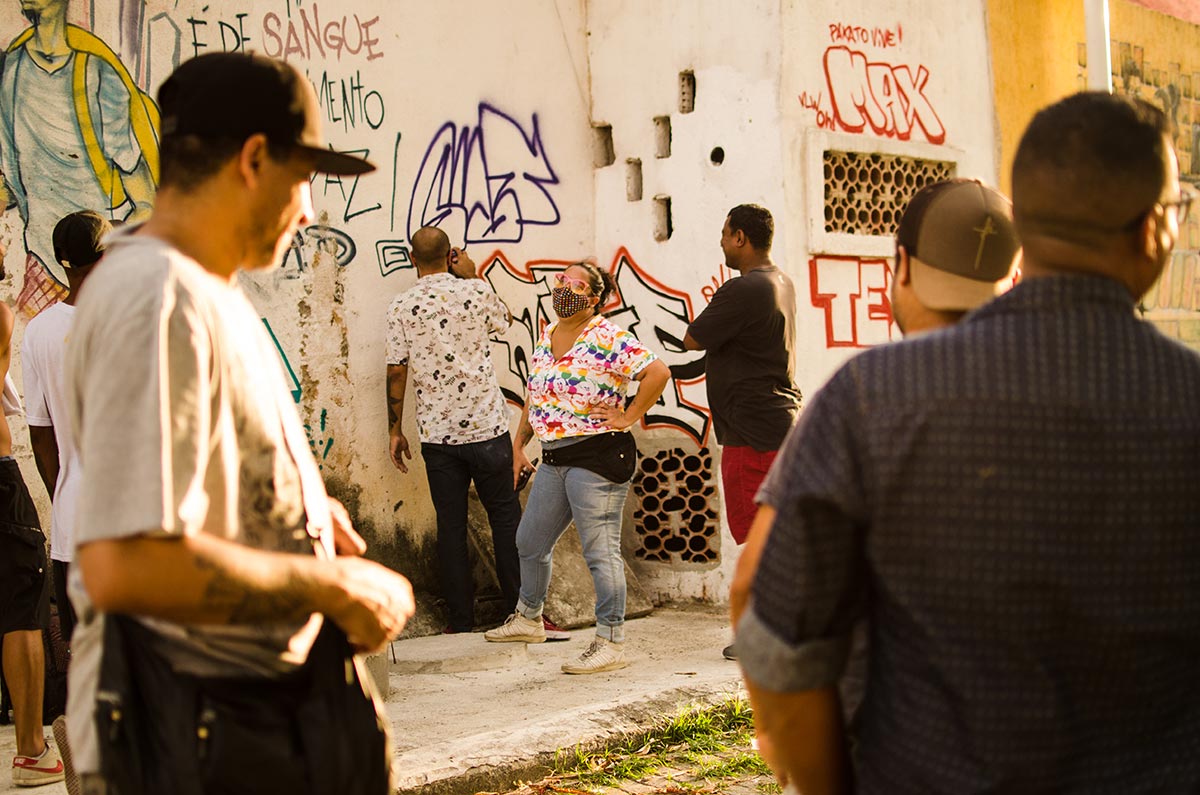
Sharing is Resisting
Sharing experience is a powerful means of liberation and inspiration for other women, children, and adolescents to recognize and denounce abusive relationships and empower themselves. Whether via individual and collective social initiatives vital support networks have been built with the persistence of the work of women and feminists, ensuring services of assistance, protection, and information for abused victims. Whether through art or political activism, the sense of giving visibility to violence against women is a strategy of solidarity, an overcoming where sharing is resisting. The work of many [pioneering women] in São Gonçalo has been fundamental in this hidden struggle.
***
Laura Lima
Is 27 years old. She has a graduate degree in history (Universidade Estadual de Rio de Janeiro) and masters in social policy (Universiade Federal Flumiense). In recent years, she has been dedicated to education in schools and cultural spaces, developing activities aimed at promoting the democratization of culture, art and science, as well as awareness and promotion of human rights, seeking to be always attentive to intersectionality. Today, she works as a history teacher and is engaged in academic research on women’s public policies. She is also a photographer, a lover of warm and saturated colors and the beauty of everyday life.
Renata Bazilio da Silva
Teacher and geographer, with degrees from Universidade Federal Fluminense (UFF) and Universidade Estadual de Rio de Janeiro with an undergraduate specialization in gender and sexuality studies and masters in culture and territorialities. She has taught geography for elementary school and pre-university entrance exams. As a geographer, in addition to the Women’s Movement in São Gonçalo, she has worked in various NGOs and projects. Her master’s research focused on cartographies of graffiti in São Gonçalo, furthering her interest in urban art, which plans to develop further with a view to contributing interdisciplinary perspectives of practices in art and science.
1 Inspired by the writing of Heleieth I. B. Saffioti.
2 Drawing on the structuring concepts of geography – space, place, territory, region and landscape – I immersed myself in questions and meanings of territorialities in the creation of Mapa da Rede de Atendimento à Mulher em Situação de Violência de São Gonçalo (Map of Services for Women in Situations of Domestic Violence in São Gonçalo) 2013.
3 São Gonçalo, Ipiíba, Monjolos, Neves, Sete Pontes.
4 Feminicide as defined by Brazilian Federal Law nº 13.104, March 9th, 2015
5 Luciana Bittencourt and Luci Faria Pinheiro, “Mulheres, direitos e participação social: a construção de políticas públicas a partir das Conferências Municipais de Direitos das Mulheres de São Gonçalo,” IX Jornada Internacional de Políticas Públicas, Universidade Federal do Maranhão, 2019.
6 Conversation with editors Jessica Gogan and Luiz Guilherme Vergara, December 2020.
7 Maria da Glória Marcondes Gonh, “Mulheres em movimento. Movimento de mulheres” in Novas teorias dos movimentos sociais (São Paulo: Edições Loyola, 2012) pp.131- 160, p.147.
8 Giddens apud Stuart Hall. A identidade cultural na pós modernidade. Tradução: Tomaz Tadeu Silva, Guacira Lopes Louro (Rio de Janeiro: DP&A, 2003) p.6
9 Renata Bazilio da Silva, “Territorialidades dos movimentos de mulheres em São Gonçalo: 1980 aos anos 2010,” Undergraduate thesis, Geography Department, Universidade Federal Fluminense, 2013.
10 Aparecida Panisset. Democratic Labor Party. Mandates: 2004-2007; 2008- 2012 and law nº 164/ 2008.
11 A judge participating in the São Gonçalo Forum, assassinated by militia on August 12th 2011. In addition to her work fighting militia she also fought for women’s issues and represents a significant loss for women’s movements in São Gonçalo.
12 Brazil, Rede de Enfrentamento à Violência contra as Mulheres. Brasília, DF. Secretaria de Política para a Mulher da Presidência da República, 2011, p. 27.
13 Leda Antunes, Feminicídios e violência contra as mulheres cresceram na pandemia, mas denúncias diminuíram Celina, platform on women and diversity, O Globo (19/10/2020). https://oglobo.globo.com/celina/feminicidios-violencia-contra-mulher-cresceram-na-pandemia-mas-denuncias-diminuiram-24700296
14 Renata Bazilio da Silva, Cartografia Cultural do Graffiti a partir de São Gonçalo: memórias de 1990 aos anos 2010, Masters dissertation Culture and Territoralities, Instituto de Artes e Comunicação Social, Universidade Federal Fluminense, 2019.



